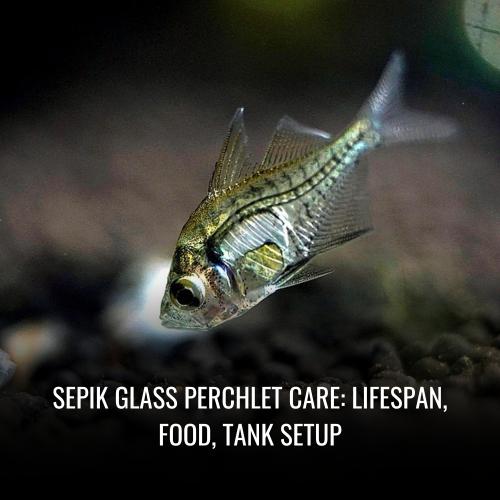Black Fin Corys play an essential role in tank maintenance, as their scavenging habits help keep the aquarium clean by eating leftover food. To ensure their well-being, it’s crucial to provide them with a diet that includes flake food, specialized bottom dweller tablets, and nutritious treats like frozen foods and baby brine shrimp. Keeping the substrate clean is also important to prevent barbel loss in these sensitive creatures.
A smooth sandy substrate, plenty of hiding spots among aquatic plants, and stable water parameters echo their lush natural environment, ensuring these cory catfish types feel at home. Male and female Black Fin Corys are distinguishable, which aids hobbyists in breeding. To facilitate breeding, setting up a separate tank is recommended during the rainy season, mimicking their natural breeding triggers.
Tank Size and Recommendations for Black Fin Corys:
| Property | Value |
|---|---|
| Scientific Name | Corydoras splendens |
| Common Name | Black Fin Cory |
| Family | Callichthyidae |
| Usual Size in Fish Tanks | 2 inches (5 cm) |
| Recommended pH Range | 6.0 – 7.5 |
| Recommended Water Hardness | 2 – 15 dGH |
| Recommended Temperature | 72°F – 78°F (22°C – 26°C) |
| Reproduction | Egg layers |
| Origin | South America, specifically the Amazon River basin |
| Temperament to Own Species | Peaceful |
| Temperament Toward Other Species | Peaceful |
| Usual Place in the Tank | Bottom, prefers low light areas |
| Lifespan | 5 – 7 years |
| Tank Size Requirement | 10 gallons |
| Filtration System | Gentle filtration with low flow |
| Sexual Dimorphism | Females are larger and broader, especially when full of eggs |
| Substrate Cleaning | Corydoras are excellent at cleaning the substrate due to their scavenging behavior, making them a valuable addition for keeping the tank clean |
Cautiously, the Black Fin Cory does possess a mild venom – an important consideration when handling it. Nonetheless, with proper care and a minimum tank size of 20 gallons, these armored catfish can be a joy to watch as they playfully forage and interact amongst their own kind and with other peaceful tank mates.
Average Size
The Black Fin Cory, recognized scientifically as Corydoras leucomelas, typically ranges in size from 2.5 to 5.1 cm (1 to 2 inches). These small, peaceful fish are perfect for community aquariums.
| Common Name | Scientific Name | Average Size |
|---|---|---|
| Black Fin Cory | Corydoras leucomelas | 2.5 – 5.1 cm (1-2 in) |
| Snow White Bristlenose Catfish | – | 1 – 5 cm |
| Pepper Cory | Corydoras paleatus | 2.5 in (males), 3 in (females) |
| Panda Corydoras | – | ~2.5 in |
| Albino Polka Dot Lyre Tail Pleco | – | Unspecified |
Lifespan
When considering the addition of Corydoras catfish to your home aquarium, it’s essential to take into account their expected lifespans. On average, these peaceful and hardy fish can be long-term aquarium inhabitants, with lifespans ranging significantly depending on the species.
For example, the Skunk Cory Catfish typically enjoys a life of 5 to 8 years. Owners of the vibrant Orange Laser Cory can expect their fish to have a lifespan of about 4 years, which still offers a considerable amount of time to enjoy these active bottom dwellers. The Black Venezuela Corydoras, with its endurance, can live up to 8 years under optimal conditions.
| Corydoras Species | Expected Lifespan in Captivity |
|---|---|
| Skunk Cory Catfish | 5 – 8 years |
| Orange Laser Cory | ~4 years |
| Black Venezuela Cory | Up to 8 years |
| Black Fin Corydoras | 15 – 25 years |
Remember, the key to a long and healthy life for any Corydoras catfish is proper care, from the quality of water and diet to the social and environmental enrichment in the aquarium.
Natural Habitat
Cory catfish originate from diverse regions across South America, inhabiting the tranquil and clear shallow streams that stretch from the lofty Andes Mountains to the broad Atlantic coast. The soft, sandy substrate of these riverbeds complements their natural bottom-dwelling behavior as they forage omnivorously for food.
The waters of their environment are characterized by a scarcity of minerals and a slight acidity, with ideal temperatures fluctuating between 70–78°F (21–25.5°C). This setting is often dappled with shade, courtesy of the dense canopy of foliage that lies above, creating a serene and dimly lit refuge.
Aquarists aiming to simulate such conditions in captivity should consider the following elements:
- Substrate: A fine, soft, or sandy substrate to mimic the natural riverbed.
- Temperature: Maintain water temperatures within the range of 70–78°F.
- pH Levels: Slightly acidic water, reflecting the mineral-deficient nature of their habitat.
- Vegetation: Ample live aquatic plants to provide the shaded and plant-rich environment.
- Shelter: Caves and driftwood to offer hiding spots.
- Social Setup: Groups are preferred, reflecting their social nature in the wild.
This careful replication of their natural habitat supports the well-being and longevity of Cory catfish in home aquariums.
Appearance
Black Venezuela Corydoras, or commonly known as Blackfin Corys, are a striking species in the Corydoras genus and an interesting addition to the freshwater aquarium hobby. Distinguishing themselves with a subtle yet charming color palette, these cory catfish typically exhibit a light olive body with a faint pale lateral band and dark scales scattered in a pattern akin to small patches.
What sets them apart is a distinguishing feature in some individuals: a black blotch adorning their dorsal fin, with varying appearances from fish to fish. Another unique identifier is the males’ pointed and extended dorsal fins, setting them apart from the rounder-bodied and more robustly built females, especially when they are gravid with eggs.
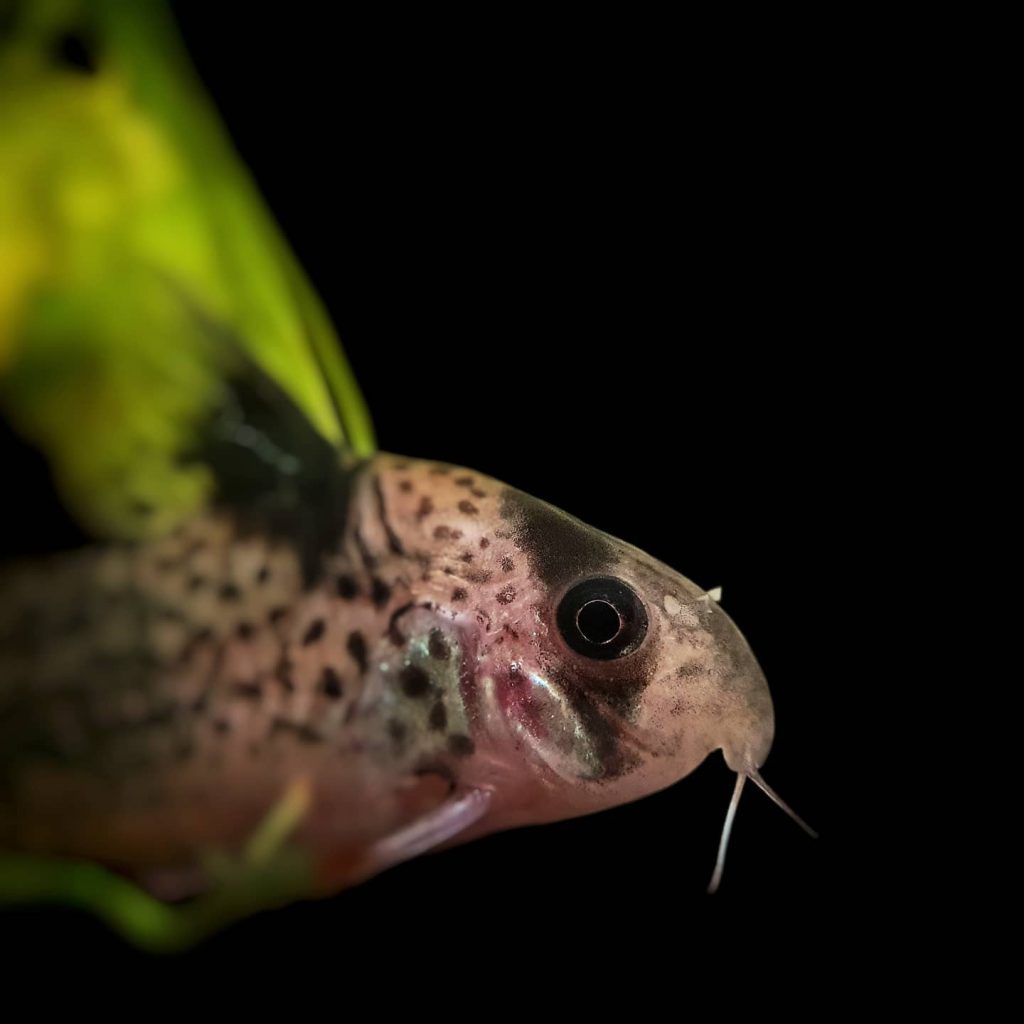
Are Black fin cory Fin Nippers?
Blackfin Corys are peaceful in nature and do not exhibit fin-nipping behavior. This characteristic makes them excellent tankmates for a range of other community fish that have long, flowing fins, such as beta fish or guppies. Their gentle nature ensures they coexist harmoniously without causing stress or harm to their tankmates by targeting their fins.
Are Black fin cory Aggressive To Each Other & Other Fish?
Blackfin Corys are known for their non-aggressive demeanor towards one another and other species in the aquarium. They are friendly and compatible with many types of peaceful community fish, as well as with other bottom-dwellers. Their placid nature makes them ideal for a stress-free community tank where aggression is not tolerated.
However, it is crucial to avoid housing them with territorial or aggressive fish such as oscars and cichlids, which might bully these shy and slow-moving catfish.
Are Black fin cory Friendly To Each Other & Other Fish?
Indeed, Blackfin Corys display friendly and social behavior towards their kind and other fish in the aquarium. They are amiable and exhibit shoaling behavior, often seen resting or foraging in groups.
They also interact well with other peaceful small fish species that share similar water parameters, like tetras and rasboras. It’s important to maintain ideal tank conditions, as a well-planted aquarium with clean substrate and regular water changes supports the congenial nature of these delightful catfish.
Are Black fin cory Schooling Fish?
Although not schooling fish in the strictest sense, Blackfin Corys thrive in a group dynamic and, therefore, display shoaling behavior. While they may not swim tightly together like typical schooling fish, they stay near each other and exhibit group behaviors that are fascinating to watch.
In their natural habitat, they are often found in loose aggregations, finding safety and social support in numbers. For these reasons, it’s beneficial to keep them in groups within the aquarium to observe their natural interactions and ensure their well-being.
Can You Have Just One Black fin cory In The Tank?
Keeping just one Blackfin Cory in a tank can lead to loneliness, stress, or even illness, as they are inherently social creatures that thrive in group settings. Stories of lone corys pining away underscore the importance of keeping them in groups.
While they do have the ability to absorb air through their intestines, which is a unique adaptation, this does not compensate for the need for social interaction with conspecifics. For the emotional and physical health of these fish, it is strongly recommended to house them with multiple individuals of their species.
Do Black fin cory Need To Be In Groups?
Absolutely, Blackfin Corys are sociable fish that express their best behavior and health in groups of six or more. A group setting not only diminishes stress but also spurs on activity, playfulness, and the display of natural shoaling behaviors among the fish.
When isolated, Blackfin Corys may become timid, hiding frequently and potentially failing to thrive. Therefore, maintaining them in groups is instrumental in promoting longevity and a vibrant life in the home aquarium.
Food & Diet
Blackfin Corys are known for their omnivorous diet and willingness to accept a variety of food sources. In their natural environment, they scavenge for worms, larvae, small insects, and vegetation in the riverbeds of South America.
Their diets are crucial for maintaining their health and vitality, and understanding their feeding habits is essential for any aquarist looking to keep these charming armored catfish.
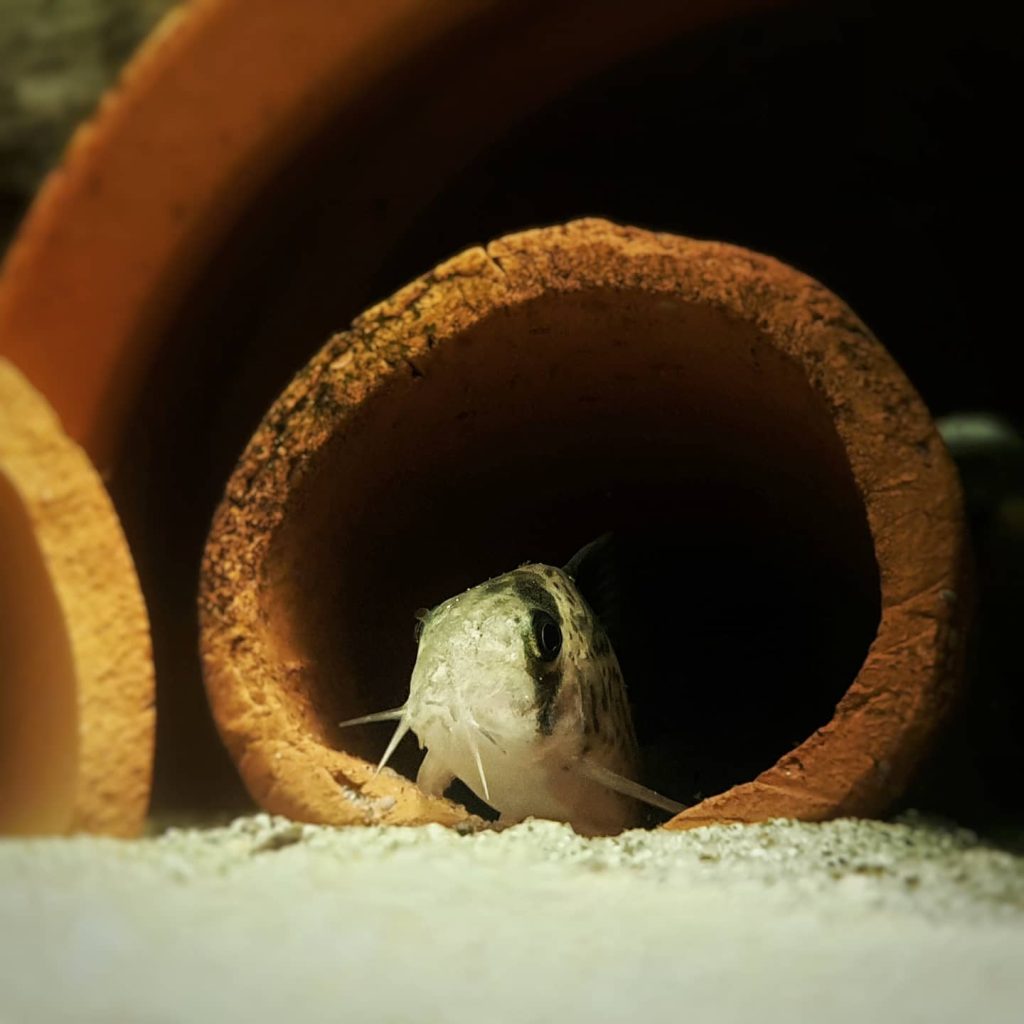
Do Black fin cory Eat Algae?
While Blackfin Corys are not primarily algae eaters, they do benefit from the inclusion of algae-based foods in their diet. Algae wafers and pellets can provide valuable nutrients and are often relished by these bottom dwellers as part of a balanced diet.
Despite this, they should not be solely relied upon to manage algae growth in an aquarium, as Corydoras are not as efficient in this role as some other fish and invertebrates.
Do Black fin cory Eat Shrimp?
In the wild, Blackfin Corys’ diet does not include shrimp, and while they are omnivores, their primary food sources are more along the lines of what they can scavenge from the substrate.
In captivity, they can be fed a variety of foods, but it is not typical to provide live or whole shrimp as part of their regular diet. Nonetheless, shrimp pellets can be a suitable part of their varied nutritional regimen.
Do Black fin cory Eat Bloodworms?
Bloodworms are among the favorite treats of Blackfin Corys and can be a rich protein source that mimics the insects and larvae they would naturally consume. However, it is important to note that bloodworms should only be given occasionally and not as the staple diet. Overfeeding bloodworms can lead to digestive issues.
A balanced approach with bloodworms featured as a supplement rather than the main course is best for the health of these fish.
Do Black fin cory Eat Mosquito Larvae?
Yes, mosquito larvae are an excellent live food for Blackfin Corys and offer variety to their diet. These larvae closely resemble what Blackfin Corys would naturally eat in their Amazon River habitat, promoting natural feeding behavior. Live or frozen mosquito larvae can be offered sparingly alongside their regular foods to ensure a well-rounded intake of nutrients.
Do Black fin cory Eat Planaria?
Although planaria are not a common part of aquarium diets, Blackfin Corys in the wild are opportunistic feeders and would likely eat planaria if available. In a home aquarium, it is not necessary to feed planaria to Blackfin Corys, but if these flatworms are present, Corydoras may partake of them.
However, an abundance of planaria may indicate overfeeding or poor tank hygiene, so it’s important to keep a well-maintained tank to avoid this issue.
Do Black fin cory Eat Plants?
Blackfin Corys are not herbivores, and they typically do not consume live aquatic plants. They may forage amongst the vegetation and occasionally nibble on decaying plant material, but they do not significantly eat or damage healthy plants. Therefore, they are safe to keep in a tank with a variety of aquatic plants, adding to the complexity of their environment without posing a threat to the flora.
Sexing: Male vs Female
Identifying the gender of Corydoras, commonly referred to as cory catfish, can be subtle, but certain physical characteristics can help. For the Skunk cory and the Leucomelas cory, including the Black Venezuela Corydoras, males are generally smaller with more streamlined bodies. Females, by contrast, showcase a rounder and fuller profile, necessary for egg carrying.
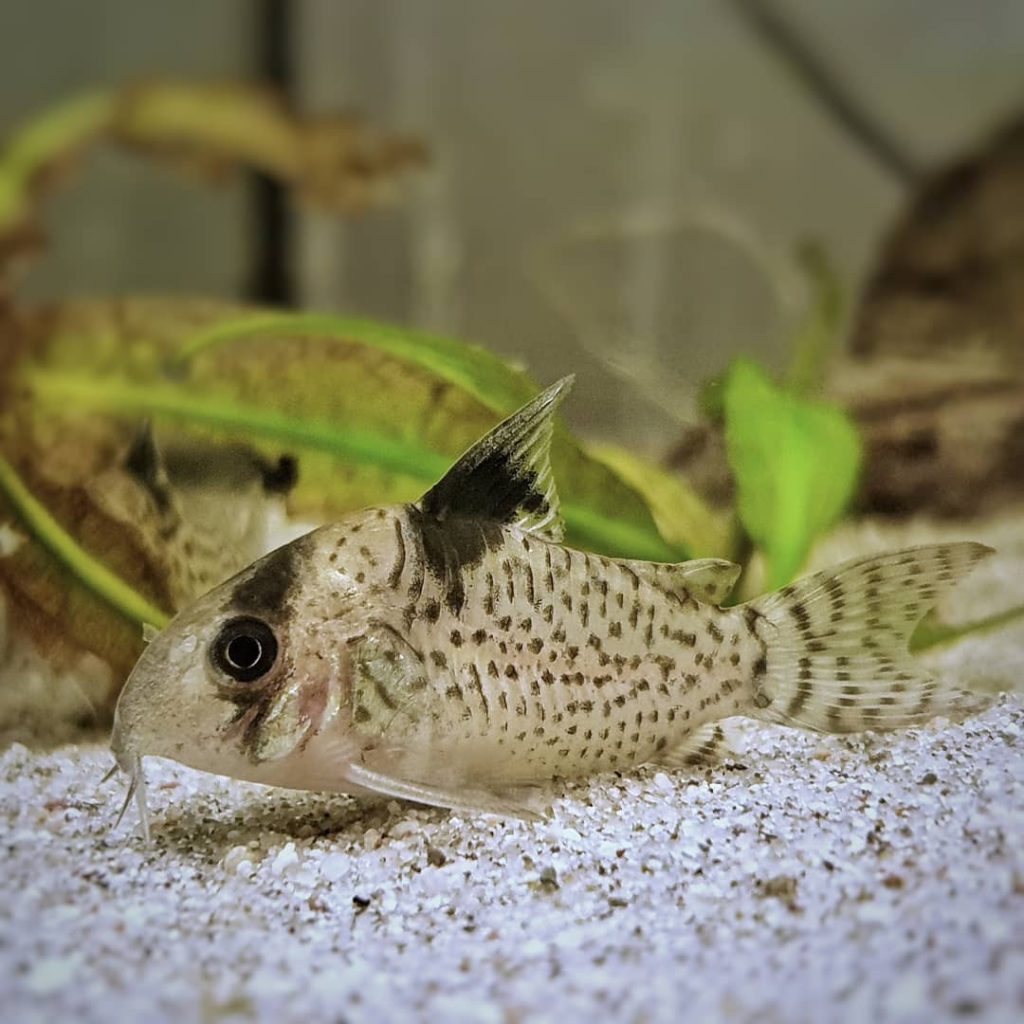
Distinguishing Features
- Skunk Cory (Corydoras arcuatus):
- Males: Smaller, thinner profile
- Females: Larger, rounder body
- Black Venezuela Corydoras (Corydoras schultzei “black”):
- Males: Pointed dorsal fin
- Females: Broader body, bulkier structure
- Leucomelas Cory (Corydoras leucomelas):
- Males: More pointed dorsal fin
- Females: Wider, more substantial body
During spawning, observation becomes clearer as the female Black Venezuela Cory deposits sticky eggs onto surfaces like plants, tank decor, or even the aquarium glass. The differences in shape and fin structure aid in positioning for egg fertilization, a behavior which further underscores the physical differences between the sexes. By paying attention to these details, enthusiasts can accurately determine the gender of their cory catfish.
Black Fin Cory Tank Mates
When setting up an aquarium for Black Fin Corys, selecting compatible tank mates is essential to create a tranquil underwater community. Peaceful fish such as tetras, guppies, mollies, and swordtails are excellent companions. Additionally, other non-aggressive catfish like plecos and otocinclus catfish can share their space without conflict.
However, it’s important to steer clear of inhabitants like oscars and larger cichlids. These aggressive species can intimidate and stress your Black Fin Corys, impacting their well-being.
Invertebrates like shrimp can also thrive alongside Black Fin Corys, provided they are not too small to be mistaken for food. Ensuring that all tankmates require similar water parameters is vital for a harmonious environment.

Here’s a quick reference for compatible tank mates:
- Tetras
- Guppies
- Mollies
- Swordtails
- Plecos (peaceful varieties)
- Otocinclus Catfish
- Shrimp (appropriately sized)
Beginners to the aquarium hobby can find success in keeping and breeding Black Fin Corys with careful consideration of these companions and a commitment to proper care.
Behavior & Temperament
Black Fin Cory fish are peaceful and sociable bottom-dwelling fish that are known for their friendly and non-aggressive nature. They are active swimmers and often provide a lively and entertaining presence in the aquarium. They are compatible with a variety of peaceful fish species, such as tetras, gouramis, and peaceful cichlids, but should not be housed with aggressive or larger fish that may bully or intimidate them.
These fish prefer a well-filtered aquarium with stable water conditions. A gentle filtration system is recommended, as Cory fish can be sensitive to strong water currents. Regular water changes and proper maintenance of the aquarium are essential to keep the environment clean and healthy for the fish.
When setting up the tank for Black Fin Cory fish, it is important to consider factors such as water parameters, including a pH level between 6.0- 7.5 and a temperature range of 72-79°F. Soft to medium-hard water is preferred. Providing adequate hiding places and smooth substrate, such as sand or smooth gravel, is also important for their well-being. Overall, Black Fin Cory fish require a peaceful and well-maintained aquarium environment to thrive.
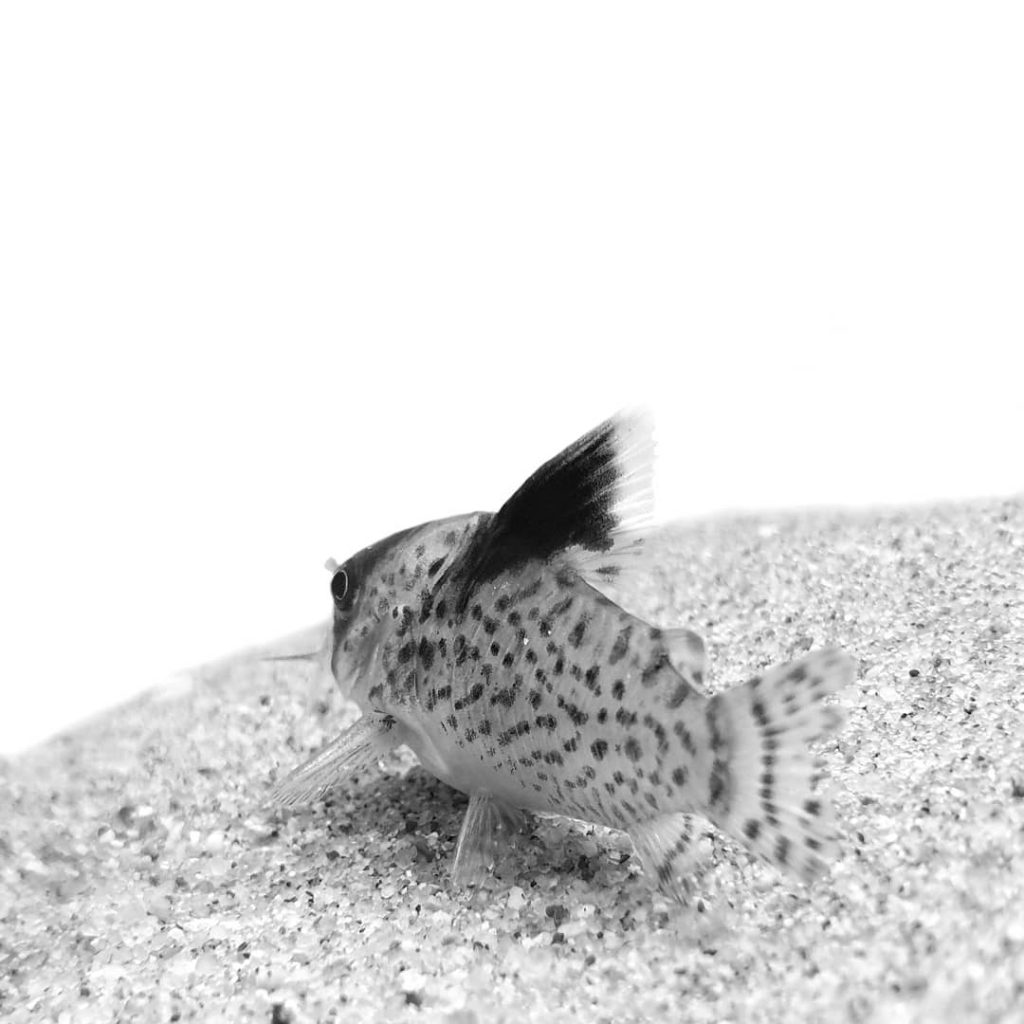
Aquarium Setup
Creating the perfect aquarium setup for Black Fin Corys (Corydoras leucomelas) is crucial to ensure their health and happiness. As these fish hail from the slow-flowing tributaries of the Amazon River in South America, replicating aspects of their natural environment in the aquarium is beneficial for creating appropriate living conditions.
Black Venezuela Corydoras enjoy a habitat with plenty of shady areas, which can be achieved with a combination of driftwood, bogwood, smooth rocks, and live aquatic plants. In addition to providing aesthetic value, these elements offer necessary refuge and replicate the dense vegetation and woody debris found in their natural habitat during the rainy season.
A soft, sandy substrate is a must for Black Fin Corys. This simulates their soft substrate in South America’s riverbeds and helps keep their delicate barbels in good condition. Harsh gravel can cause injuries, leading to infections or erosion of their sensitive barbels, so it’s best to opt for fine sand that won’t pose this threat.

Ideal Tank Size
When considering the ideal tank size for Black Fin Corys, it’s not just about the volume of water but also about the footprint of the tank. As these fish are bottom dwellers, the floor space is more critical than the height of the aquarium.
For Black Fin Corys:
- Minimum tank size: 20 US gallons (76 liters) for a small group of these fish.
- Larger species: Tanks of 50 gallons or more are preferred to provide adequate swimming space and accommodate their group behaviors.
- Dwarf species: Such as Pygmy Corys may be kept in a 10-gallon tank, although 20 gallons is suggested for greater comfort and to accommodate group dynamics.
Always consider the bioload and the cumulative needs of your tank inhabitants when deciding on tank size. As a rule of thumb, more space is always better, especially for social and active fish like the Black Fin Corys and other types of Corydoras.
Ideal Water Parameters
The Black Fin Corys are adapted to specific water parameters, which need to be replicated in the aquarium for their optimum health. Consistency and stability in water parameters are crucial as drastic changes can stress these peaceful creatures.
- pH level: They flourish in freshwater with a pH level of 6.0 – 7.5, slightly acidic to neutral conditions.
- General hardness (GH): Water hardness should be kept between 2 – 15 dGH, ensuring the softness of the water as found in their South American habitat.
- Temperature: An ideal temperature range lies between 71 – 82 ℉ (21.7 – 27.8 ℃). It is essential to mimic their natural tropical conditions without extreme fluctuations.
Specifically, the Black Venezuela Corydoras and Blacktop Corydoras may have slightly different preferences but generally fall within these parameters.
Filtration
Adequate filtration is essential for maintaining the health and well-being of Black Fin Cory fish in an aquarium. These fish are particularly sensitive to changes in water quality, and a good filtration system helps to ensure that the water remains clean and free of harmful substances.
Specifically, Black Fin Cory fish require a filtration system that provides a gentle water flow. These fish are bottom-dwellers and can be easily stressed by strong currents in the aquarium. A gentle water flow mimics their natural habitat and helps to reduce stress levels.
Additionally, efficient removal of waste and debris is important for the overall health of Black Fin Cory fish. A good filtration system should be able to effectively remove uneaten food, fish waste, and other organic matter from the water. This helps to maintain water quality and prevents the buildup of harmful substances that can negatively impact the fish’s health.
Lighting
Black Fin Cory fish are native to the Amazon River basin and are typically found in heavily vegetated, shaded areas with dappled light. In their natural habitat, they are used to low to moderate light levels. When kept in an aquarium, it is important to replicate this natural lighting environment for them to thrive.
The ideal light intensity for Black Fin Cory fish is low to moderate, with gentle, diffused lighting to mimic their natural habitat. They do not do well in bright, direct lighting and can become stressed or agitated in such conditions. A photoperiod of 8-10 hours of light per day is ideal for these fish, allowing for a natural day-night cycle.
When using artificial lighting in the aquarium, it is recommended to use low-intensity LED lights or fluorescent lights that can be dimmed to create a subdued lighting environment. The use of floating or submerged plants can also help diffuse the light and provide the fish with places to seek shelter if they feel overwhelmed.
Common Possible Diseases & Prevention of Black Fin Cory fish
Fin rot is often caused by poor water quality and can be prevented by maintaining a clean tank with regular water changes and proper filtration. Ich, or white spot disease, can be prevented by quarantining new fish and ensuring the tank water is within the appropriate temperature range. Bacterial infections can be prevented by making sure the tank has good water circulation and using a quality aquarium salt to maintain a healthy environment.
To maintain a healthy tank environment, it is important to regularly clean the tank and perform water tests to ensure proper water parameters. The tank should be properly cycled before adding new fish and any uneaten food or waste should be removed promptly. Providing a balanced diet and avoiding overfeeding can also help keep the fish healthy and disease-free.

Breeding Black Fin Cory In Aquarium
Breeding Black Fin Corys in an aquarium setting requires attention to their unique spawning conditions. The process begins with setting up a separate breeding tank to closely mimic their fast-flowing natural blackwater habitats, such as floodplain lakes and forest streams. This tank should have a white sandy substrate, bare bottom, or fine gravel to align with their natural spawning grounds. An air-powered sponge filter is essential to keep the water clean without generating strong currents.
For successful breeding, maintain a higher ratio of males to females; ideally, two males for every female. This instigates natural competition and increases the chances of fertilization. Conditioning the breeding groups with a varied diet is crucial. Feed them a mix of dried, live, and frozen foods to ensure they are in prime breeding condition.
Ensure the breeding habitat includes elements such as submerged wood, driftwood, and leaf litter to provide a familiar environment. Avoid adding dwarf crayfish to the setup, as they may harm the delicate Corys.
By carefully replicating the Black Fin Corys’ breeding conditions and managing their diet and environment, aquarists can significantly improve the odds of witnessing the fascinating breeding behavior and perhaps welcoming a new generation of these charming catfish into their aquarium community.
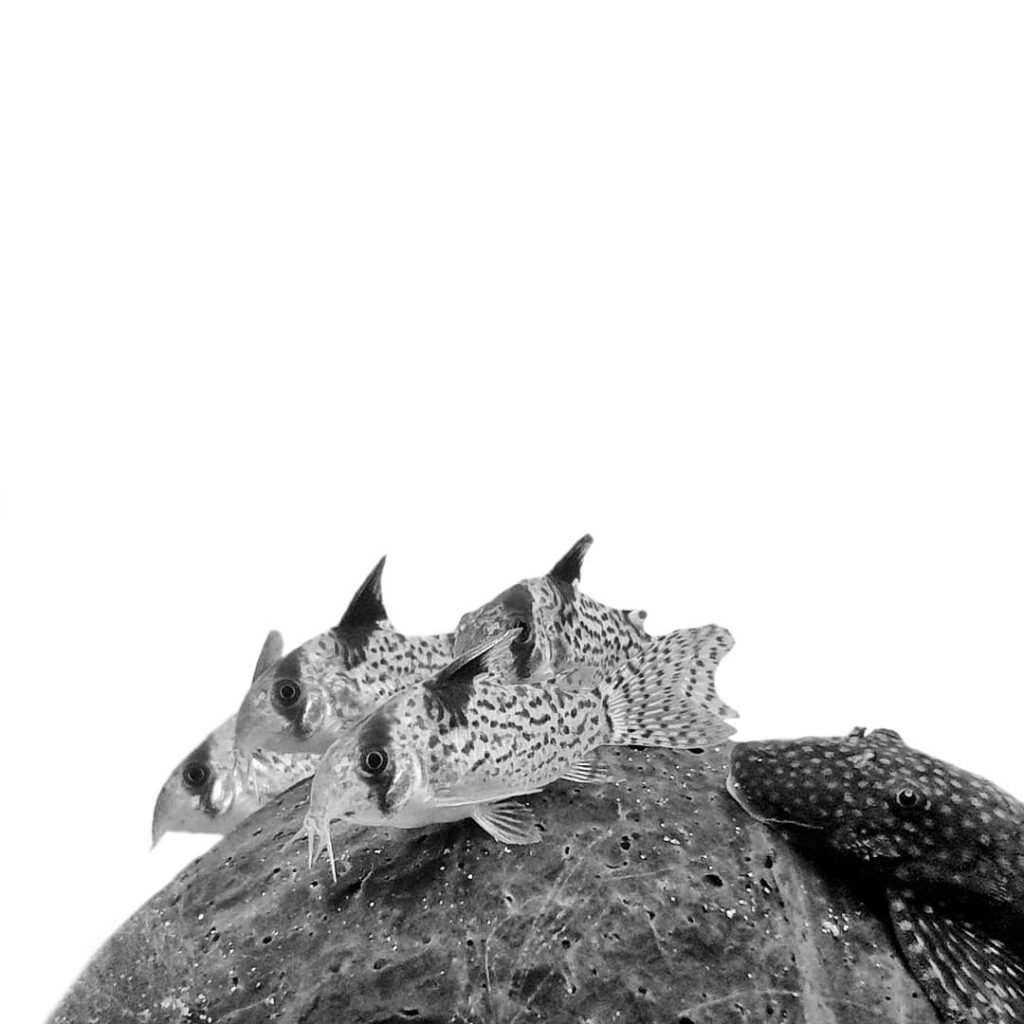
Are Black fin cory Easy To Keep?
Black fin cory catfish, recognized by their peaceful nature and affable temperament, are generally considered manageable fish for experienced aquarium hobbyists. However, beginners should proceed with caution, as these South American natives demand vigilant care to ensure their well-being.
A well-planted aquarium, simulating their natural Amazonian blackwater conditions, is beneficial. Their requirements include a sound maintenance schedule that features regular, significant water changes to prevent a detrimental buildup of wastes. Finely-grained, soft substrate is ideal, as rough and unclean substrate may contribute to the loss of their sensitive barbels — whisker-like organs used for sensing their environment.
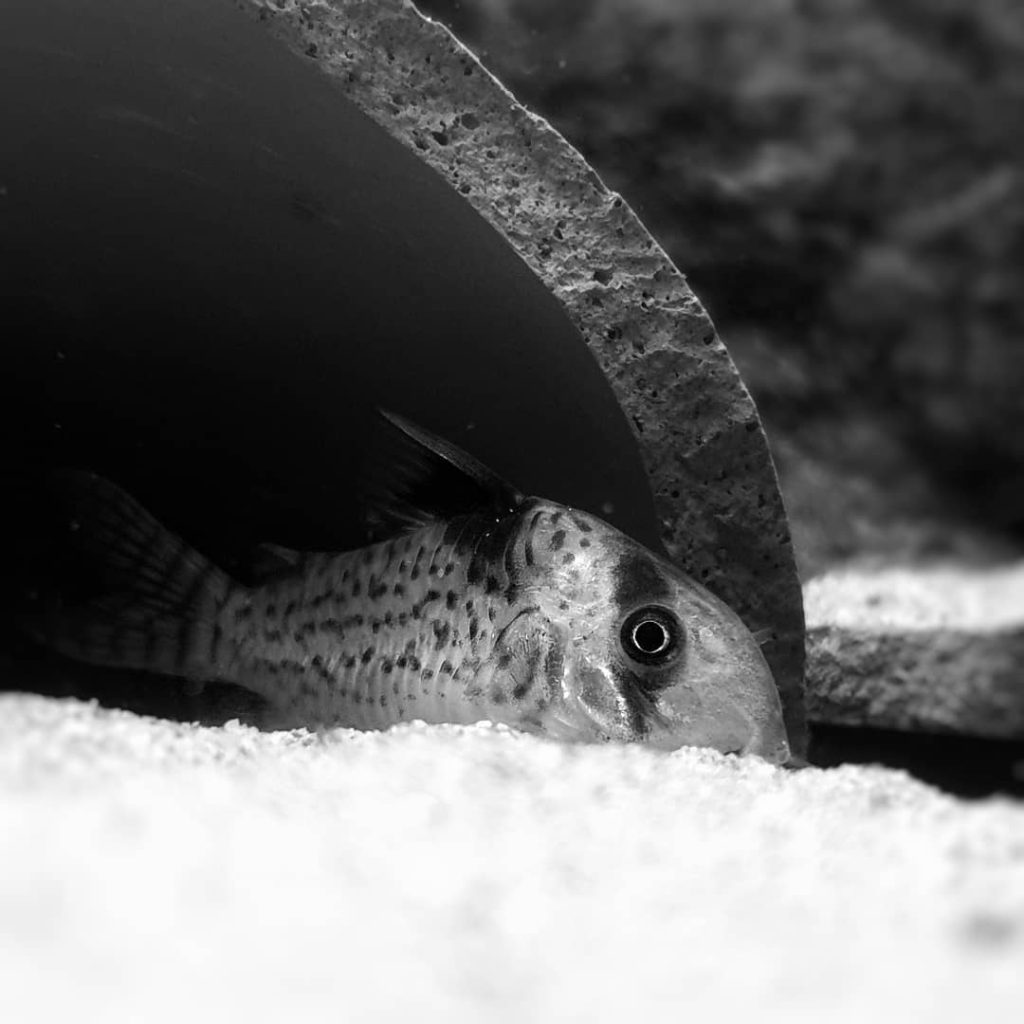
Are Black fin Cory Sensitive To Water Changes?
Black fin cory catfish are notably perceptive to the quality of their aquatic environment. They thrive best when water parameters are stable and consistent; thus, sudden or drastic changes can induce stress and harm these delicate creatures. Maintaining a robust regimen of significant water changes, yet incremental is paramount.
Typically, replacing 25-30% of the water volume every week is acceptable, ensuring the integrity of water parameters while gently easing the stories into new conditions. Careful acclimation to new water chemistry is vital to minimize shock. Aquarists should also avoid altering water temperature abruptly, as this too can negatively affect black fin corys.
Are Black fin cory Sensitive To Ammonia?
The black fin cory’s sensitivity extends towards ammonia, a common yet harmful nitrogenous waste product in aquariums. Elevated levels of ammonia are particularly perilous for these fish, even more so than for some other species. Ensuring that their aquatic habitat is well-cycled to establish beneficial bacterial colonies that convert ammonia into less harmful substances is imperative.
Ammonia levels should be closely monitored, and the aim should always be to maintain a reading of zero. Good filtration, routine water testing, and timely water changes are the cornerstones for controlling ammonia and safeguarding the health of black fin corys.
Are Black fin cory Sensitive To Copper?
Much like other cory catfish, black fin corys exhibit a vulnerability to copper, which is often present in tap water or may be introduced through some aquarium medications. Their intolerance to copper underscores the importance of using water conditioners that neutralize heavy metals when filling the tank.
Additionally, when treating sick tank inhabitants, aquarists should select medications that are labeled as safe for scale-less and sensitive fish like the black fin cory. If in doubt, it’s recommended to isolate the sick fish and treat them in a separate quarantine tank to prevent accidental exposure of black fin corys to copper or other harsh chemicals.

